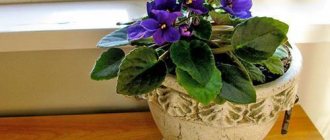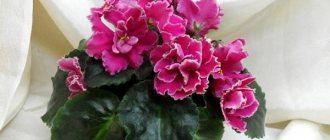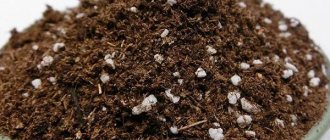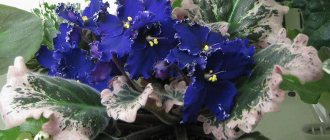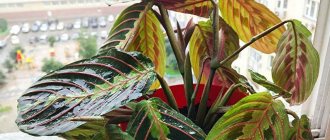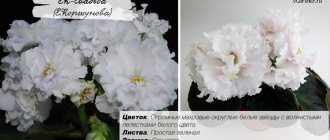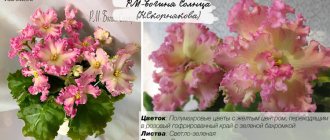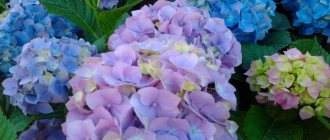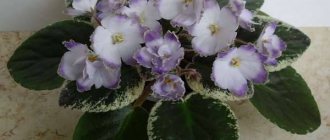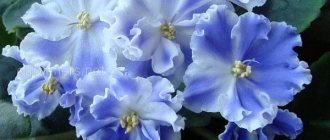The history of one of the most popular indoor plants began in 1892, when Walter von Saint-Paul took a routine walk through the picturesque surroundings of the district entrusted to him by the German government in East Africa.
Being the son of a prominent dendrologist, the commandant himself had a genuine interest in the unusual flora of the exotic region. Small pubescent rosettes with dense oval leaves and single purple flowers growing between the stones attracted the baron’s attention.
Therefore, having collected small seeds of an unknown crop, he sent them home. The very next year, the first shoots were obtained, the plant was described and named in honor of the discoverer.
Today, photos of Uzambara violets or Saintpaulias are easily recognized by all lovers of indoor floriculture. It is difficult to imagine that a plant, first presented at an exhibition just over a hundred years ago, was already recognized as the most popular in the United States in 1927, although by that time the cultivated varieties of violets could be counted on one hand.
Thanks to tireless breeding work, to date more than thirty thousand varieties of violets have been obtained, whose names and photos excite the imagination of lovers of this culture.
Violet Blue mist
The shining, light flowers of the Blue Mist violet, bred by K. Morev, have a star-shaped shape, sky-blue color and an amazing wavy edge, giving Saintpaulia airiness and freshness. The corollas are very large, densely double. The petals are decorated with a wide white border. Standard size socket. The foliage is light green, ovoid in shape with a wavy edge and a notch in the center of the leaf blade. The bloom of the Blue Mist violet is widespread, and the plant will become the center of any collection.
Violet blue bird
Not everyone knows that Uzambara violets were originally blue in color. It was cornflower blue, indigo, and sapphire indoor beauties that conquered the world. Even in ancient times, blue symbolism was highly valued. This color was associated with modesty and purity of thought.
In the article we will look at the most beautiful blue violets, their characteristics and external features. We invite you to look at a photo gallery of these indoor plants of extraordinary beauty. Below you will read in more detail a description of the 9 main blue varieties.
In addition to them, it is also worth highlighting the following cornflower blue violets: Arabian Night, Aphrodite, African Night, Running on the Waves, Viscount, Misty Cloud. The Heavenly Queen violet is also very impressive. Many varieties will be described in the article.
Some violets bloom once a year, others produce only a few peduncles, and others are distinguished by beautiful blue caps two to three times a year for two months. For frequent and abundant flowering, carry out the following activities:
- Watch the lighting. The flower loves intense light. The best place for it is on the windowsill, 30 centimeters from the window.
- Use artificial lighting on short days.
- After two weeks, feed with violet fertilizer.
- Water regularly with soft water at room temperature.
- Use nitrogen-rich soil for planting.
If you listen to our advice, then all of the above varieties of blue and cyan violets will delight you with abundant flowering.
Violet Blue Dragon
Saintpaulia Blue Dragon has a very beautiful name, isn’t it? And the flower is even more beautiful! It is distinguished by semi-double and double stars of light blue color. In the center of the blooming rosette the flowers are dark blue, which makes them stand out very effectively. The petals have a purple or light green border. In the photo above are blue violets Blue Dragon.
It can be seen that the flower is decorated with dark green foliage with slightly jagged edges. The leaves are slightly reddish on the underside. Blue Dragon is a fairly large variety with a powerful rosette of buds and succulent leaves. The rosettes are vase-shaped. The petioles first stretch upward and then unfold into leaf blades horizontally. The emerging leaves are slightly curled, but then straighten out.
A blooming rosette of flowers resembles a terry hat. Each petal has a reddish-purple ruffled border, resembling a ruffle. Maybe the variety is called Blue Dragon because an ominous purple border appears on the light background of the flowers. This violet blooms profusely and willingly, like a bouquet. The flower size in diameter can be 7 cm.
The Extraordinary Blue Danube
This variety is considered a very striking representative of blue Saintpaulias. It was bred by Russian breeders. The Blue Danube violet has wavy, matte, jagged green leaves.
The color of the flowers resembles the waters of the famous Danube, which is why the name is appropriate. Flowers can reach 5 cm in diameter.
To obtain abundant flowering, the Blue Danube violet should be placed in well-lit places.
It requires a lot of moisture. It blooms for a very long time if you place it in a room with the right temperature. Any gardener will be happy with indoor flowers of the Blue Danube variety. This is a great addition to your Saintpaulia collection. Thanks to its valuable decorative qualities, the flower can decorate any interior.
Violet variety Sea Wolf
In 2006, breeder Elena Vasilyeva developed the inimitable Saintpaulia. And its name is very unusual - Sea Wolf. Flower petals, looking like delicate ruffles, resemble sea waves.
This violet can be seen at many exhibitions. Among all the blue varieties, it has the largest flowers. Characterized by large leaves, like burdock.
At first the leaves are even, but then they turn horizontally and give the rosette the opportunity to run wild.
Peduncles form real bouquets of fluffy flowers. In the photo above you can see the smooth, neat and symmetrical rosette of this variety. The plant completely surrounds the pot with its leaves.
The blue flowers themselves are very large, up to 9 cm in diameter. Simply beautiful! In the second flowering, the fullness of the petals increases.
The original bright blue color of the flowers and the dark leaves of the plant go well together.
This Saintpaulia thrives in natural light. Under optimal conditions, the plant can delight the owner with constant flowering. It is best to select small pots for it. It will be best for her on the windowsill on the north, northeast, northwest side. She doesn't like too bright lighting.
Uzambara violet Magic Night
This is a truly mesmerizing flower with deep blue double flowers sprinkled with pink polka dots. Sometimes the petals are decorated with white spots, this resembles a starry sky. The velvet leaves of the Magic Night are rich green in color with original teeth. Characterized by a large but compact outlet.
Its double flowers are blue-purple. Raspberry peas on the petals make the flower very mysterious. The flowers themselves are medium in size, but there are many of them on the peduncles.
Flowering stems form a variegated cap. Flowering is quite long and abundant. For the first time, the flowers may not have peas. This variety is very unpredictable. Sometimes there are 1 - 2 spots on the petals, and sometimes there are many of them.
In a well-lit room, you can place this violet on a shelf or table. But the best place would be the windowsill. The plant loves frequent watering and reminds of this with drooping leaves. Sometimes he goes into sports, then the flowers turn purple. A very beautiful variety, you can admire it in the photo below.
Variety Beautiful Creole
This Saintpaulia was bred by domestic breeders. This indoor flower is also called a bright beauty with an easy-going character. Its flowers are bright blue with a purple tint. This is a fairly prolific plant with increased resistance to unfavorable conditions. It is very easy to propagate, because new babies are constantly appearing.
We invite you to familiarize yourself with the effect of cracked paint
The photo of the Beautiful Creole will not leave lovers of Uzambara violets indifferent. Admire her in the photo below. Isn't that so, gorgeous beauty? Pay attention to its semi-double star flowers. Their petals at the edges are decorated with a white-green border, like ruffles. The flowers reach 5 cm in diameter.
Peduncles are characterized by a dark burgundy color, strong and durable structure. The variety is distinguished by dark green leaves, slightly pubescent, with a slight wave along the edge. Forms a neat, symmetrically developing rosette with a diameter of up to 30 cm. This Saintpaulia loves standard conditions with natural light.
Spraying the fleecy leaves of the Beautiful Creole violet is strictly prohibited. They may then rot or dry out. Every two weeks it is worth combining watering the plant with fertilizing. For this, it is best to use liquid fertilizers. Every year the plant is replanted. Young rosettes can be replanted in autumn and spring.
EK-Blue Frost
Many people like this variety for its rich cornflower blue color. The plant is unpretentious, grows well and blooms quickly. The bush is formed in the form of a symmetrical rosette. Feels great on the windowsill and shelving. The peduncles of violet EK-Blue Frost are short.
The variety is distinguished by large semi-double blue stars with corrugated petals. There is a white edging along the edges. The sockets form independently. First the leaves grow upward and then hug the pot. Blooms for a long time, in the form of a bouquet. The plant is almost always in flowers. It can go into sport and form a new variety EK-Nautilus.
The plant is distinguished by its unpretentiousness, stability, and rapid growth. Being on the windowsill, it gives a larger rosette than in the shade. Admire the Blue Frost variety in the photo below. Indeed, it seems that the flowers are covered with light white frost along the edges.
Gift for Loved One
This hybrid has large double fringed blue flowers, along the edge of which there is a red-purple border. Violet Gift for Beloved is an exhibition plant with a perfect rosette that forms independently.
The flowers have a dark blue color and a fairly clear border. There are many buds on the peduncles, forming real caps. Large and bright flowers last a long time, up to a month and a half. The variety has positive parameters and is unpretentious to lighting.
Pay attention to the leaves of this indoor plant. They are also very decorative. They are dark green in color with a creamy pink border. Even without flowers, the rosettes look elegant.
Even a photo cannot convey all the beauty of the Gift for Beloved variety. You can really give it as a present to your man. A neat rosette looks very harmonious.
The unique Blue Lagoon
Do you know what a lagoon is? This is a shallow body of water, connected to the sea by a narrow strait, with heavenly colored water. So, this is exactly the color of the Blue Lagoon violet. The flower is characterized by semi-double bright blue stars. In its center there is a bright blue spot. The edges of the petals resemble a purple flounce.
The bush resembles a medium-sized compact green rosette. It has a compact, flat, symmetrical shape and can reach a diameter of 30 cm. If the plant does not have enough light, it stretches its leaves upward.
The flowers are cold blue in color and reach a diameter of 6 cm. The edges of the petals are decorated with a wide soft lilac border. The variety resembles the Blue Dragon in color, but the flower shape is different. If you look closely at the flower, you will notice a green stripe at the tips of the petals. At different temperature conditions, the color of this border may change.
The older the rosette becomes, the more elegant its bouquet. The plant blooms profusely, the flower stalks produce many buds. You can enjoy flowering for a long time. As soon as some flower stalks fade, new ones immediately appear. This continues for about 2.5 months. It is very easy to grow Blue Lagoon with the help of babies or leaves.
Blue variety Summer Twilight
This wonderful blue Saintpaulia became a delightful masterpiece of the breeder Konstantin Morev. Violet Summer Twilight is on the lips of many today. She was loved by flower growers for her extraordinary brightness. Sometimes it is also called Morev's violet. It is memorable for its variegated leaves and petals. This Saintpaulia forms a neat, flat, medium-sized rosette.
This variety cannot be confused with any other. It is distinguished by large double and semi-double stars up to 6 cm in diameter. Each petal in the center has a blue-violet color and a white edge. We must pay tribute to the velvety petals with a wavy edge. Bright, lush, voluminous flowers attract attention. There may be so many buds on the flower stalks that they sag under their weight.
Saintpaulia Summer Twilight blooms long and abundantly. Even young rosettes tend to bloom. Caring for this variety is not very difficult. Even beginners can wait for it to bloom.
A flower pot can be placed either on a windowsill or on a shelf. The plant should be protected from too bright sun so that the white spots on the leaves do not get burned. This violet loves cool weather.
In hot weather, the variegated leaves become duller. Excessive lighting leads to drooping leaves.
Source: https://english-usa.ru/fialka-sinyaya-ptitsa/
Violet Duchess
In the photo there is a Duchess violet from S. Repkina. This variety of Saintpaulia is well known to flower growers in the CIS countries, because, like other “brainchildren” of this breeder, it invariably pleases with its beautiful flowering and easy-going disposition. The flowers of the Duchess violet are huge, semi- or double, with a wavy patterned edge. The flowers are decorated with plum-colored spots in the center of the petals. The variety stands out for its powerful rosette and beautiful dark green foliage with noticeable veins, giving the leaf blades a quilted appearance.
The Duchess Lux violet, obtained from a parent plant that is similar in appearance, also has noticeable differences. Moreover, both varieties have beautiful large flowers, pleasing with the number of petals and shape. In Duchess Lux, a green fringed border is clearly visible along the edge of the petals. The leaves of this variety are lighter in color and have beautiful wavy edges.
Blue violet: names and descriptions of varieties. Variety Blue Dragon. EK-Blue Frost. Violet Blue Lagoon
Home comfort October 25, 2018
Many housewives love to grow delicate indoor violets on their windowsills. There are so many varieties you won’t find at the flower market today. Most of all, many people are familiar with blue violets. Their colors range from soft blue to velvet blue. Today we will look at the most luxurious varieties of blue violets. Its scientific name is Saintpaulia, or Uzambara violet.
The rich world of blue Saintpaulias
Not everyone knows that Uzambara violets were originally blue in color. It was cornflower blue, indigo, and sapphire indoor beauties that conquered the world. Even in ancient times, blue symbolism was highly valued. This color was associated with modesty and purity of thought.
In the article we will look at the most beautiful blue violets, their characteristics and external features. We invite you to look at a photo gallery of these indoor plants of extraordinary beauty. Below you will read in more detail a description of the 9 main blue varieties.
In addition to them, it is also worth highlighting the following cornflower blue violets: Arabian Night, Aphrodite, African Night, Running on the Waves, Viscount, Misty Cloud. The Heavenly Queen violet is also very impressive. Many varieties will be described in the article.
Violet Blue Dragon
Saintpaulia Blue Dragon has a very beautiful name, isn’t it? And the flower is even more beautiful! It is distinguished by semi-double and double stars of light blue color. In the center of the blooming rosette the flowers are dark blue, which makes them stand out very effectively. The petals have a purple or light green border. In the photo above are blue violets Blue Dragon.
It can be seen that the flower is decorated with dark green foliage with slightly jagged edges. The leaves are slightly reddish on the underside. Blue Dragon is a fairly large variety with a powerful rosette of buds and succulent leaves. The rosettes are vase-shaped. The petioles first stretch upward and then unfold into leaf blades horizontally. The emerging leaves are slightly curled, but then straighten out.
A blooming rosette of flowers resembles a terry hat. Each petal has a reddish-purple ruffled border, resembling a ruffle. Maybe the variety is called Blue Dragon because an ominous purple border appears on the light background of the flowers. This violet blooms profusely and willingly, like a bouquet.
The diameter of the flower can be 7 cm. The peduncles are very persistent and elastic. There are up to 8 buds on one stem. Particularly bright flowering is observed in winter. In summer, the petioles begin to grow and the leaves rise up.
The Blue Dragon owes its abundant flowering to its powerful root and leaf apparatus.
Violet variety Sea Wolf
In 2006, breeder Elena Vasilyeva developed the inimitable Saintpaulia. And its name is very unusual - Sea Wolf. Flower petals, looking like delicate ruffles, resemble sea waves.
This violet can be seen at many exhibitions. Among all the blue varieties, it has the largest flowers. Characterized by large leaves, like burdock.
At first the leaves are even, but then they turn horizontally and give the rosette the opportunity to run wild.
Peduncles form real bouquets of fluffy flowers. In the photo above you can see the smooth, neat and symmetrical rosette of this variety. The plant completely surrounds the pot with its leaves.
The blue flowers themselves are very large, up to 9 cm in diameter. Simply beautiful! In the second flowering, the fullness of the petals increases.
The original bright blue color of the flowers and the dark leaves of the plant go well together.
This Saintpaulia thrives in natural light. Under optimal conditions, the plant can delight the owner with constant flowering. It is best to select small pots for it. It will be best for her on the windowsill on the north, northeast, northwest side.
She doesn't like too bright lighting. The ideal temperature for the Sea Wolf variety is +20 °C. The plant does not like drafts, so there is no need to keep the doors open. Leaves and flowers do not tolerate spraying. Watering should also be careful and regular.
This is best done with a watering can.
Variety Beautiful Creole
This Saintpaulia was bred by domestic breeders. This indoor flower is also called a bright beauty with an easy-going character. Its flowers are bright blue with a purple tint. This is a fairly prolific plant with increased resistance to unfavorable conditions. It is very easy to propagate, because new babies are constantly appearing.
The photo of the Beautiful Creole will not leave lovers of Uzambara violets indifferent. Admire her in the photo below. Isn't that so, gorgeous beauty? Pay attention to its semi-double star flowers.
Their petals at the edges are decorated with a white-green border, like ruffles. The flowers reach 5 cm in diameter. The blooming rosette resembles a bouquet, but not a hat. Flowering occurs in waves, each period lasting approximately 40 days.
There may be three such waves in a year.
Peduncles are characterized by a dark burgundy color, strong and durable structure. The variety is distinguished by dark green leaves, slightly pubescent, with a slight wave along the edge.
Forms a neat, symmetrically developing rosette with a diameter of up to 30 cm. This Saintpaulia loves standard conditions with natural light.
If the room is below +20 °C, the border on the petals turns green instead of white. In winter, lighting with fluorescent lamps is possible.
Spraying the fleecy leaves of the Beautiful Creole violet is strictly prohibited. They may then rot or dry out. Every two weeks it is worth combining watering the plant with fertilizing. For this, it is best to use liquid fertilizers. Every year the plant is replanted. Young rosettes can be replanted in autumn and spring.
Gift for Loved One
This hybrid has large double fringed blue flowers, along the edge of which there is a red-purple border. Violet Gift for Beloved is an exhibition plant with a perfect rosette that forms independently.
The flowers have a dark blue color and a fairly clear border. There are many buds on the peduncles, forming real caps. Large and bright flowers last a long time, up to a month and a half. The variety has positive parameters and is unpretentious to lighting.
Pay attention to the leaves of this indoor plant. They are also very decorative. They are dark green in color with a creamy pink border. Even without flowers, the rosettes look elegant.
Even a photo cannot convey all the beauty of the Gift for Beloved variety. You can really give it as a present to your man. A neat rosette looks very harmonious.
Blue variety Summer Twilight
This wonderful blue Saintpaulia became a delightful masterpiece of the breeder Konstantin Morev. Violet Summer Twilight is on the lips of many today. She was loved by flower growers for her extraordinary brightness. Sometimes it is also called Morev's violet.
It is memorable for its variegated leaves and petals. This Saintpaulia forms a neat, flat, medium-sized rosette. Slightly concave quilted green leaves have a blurry white border at the edges.
It is the contrast of blue and white that makes this beauty recognizable.
This variety cannot be confused with any other. It is distinguished by large double and semi-double stars up to 6 cm in diameter. Each petal in the center has a blue-violet color and a white edge. We must pay tribute to the velvety petals with a wavy edge. Bright, lush, voluminous flowers attract attention. There may be so many buds on the flower stalks that they sag under their weight.
Saintpaulia Summer Twilight blooms long and abundantly. Even young rosettes tend to bloom. Caring for this variety is not very difficult. Even beginners can wait for it to bloom.
A flower pot can be placed either on a windowsill or on a shelf. The plant should be protected from too bright sun so that the white spots on the leaves do not get burned. This violet loves cool weather.
In hot weather, the variegated leaves become duller. Excessive lighting leads to drooping leaves.
Tips for caring for blue Saintpaulias for better flowering
Some violets bloom once a year, others produce only a few peduncles, and others are distinguished by beautiful blue caps two to three times a year for two months. For frequent and abundant flowering, carry out the following activities:
- Watch the lighting. The flower loves intense light. The best place for it is on the windowsill, 30 centimeters from the window.
- Use artificial lighting on short days.
- After two weeks, feed with violet fertilizer.
- Water regularly with soft water at room temperature.
- Use nitrogen-rich soil for planting.
If you listen to our advice, then all of the above varieties of blue and cyan violets will delight you with abundant flowering.
Source: .ru
Source: https://monateka.com/article/292758/
Violet Winter smiles
The elegant variety of violet Winter Smiles belongs to the most famous and oldest breeder of Russia B. Makuni. Compact plants generously reward the lover of this culture with semi-double or double flowers with a diameter of up to 5.5 cm. The color of the petals is complex and harmonious. A light pink background, on which crimson tint strokes stand out. The fringed edge, reminiscent of frost sparkling at dawn, has a delicate yellow-green tone. When keeping plants in a hot room, the border becomes lighter to white. The flat rosette of Uzambara violet, as in the photo, consists of green rounded leaves, sometimes with an olive tint. The edges of the foliage are jagged, the leaf blade is embossed and quilted.
